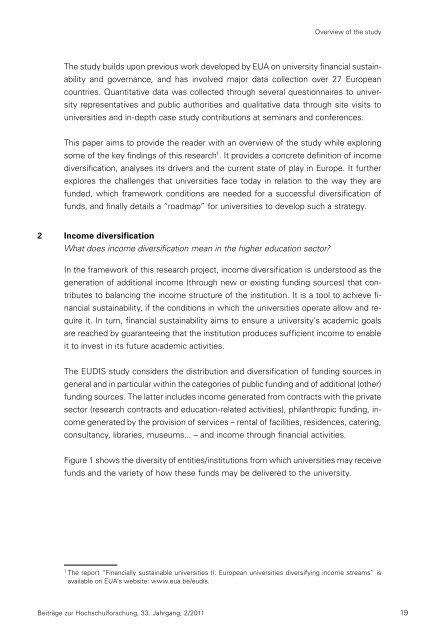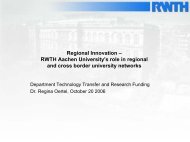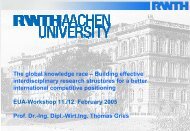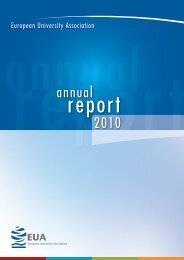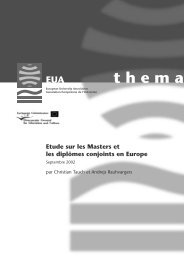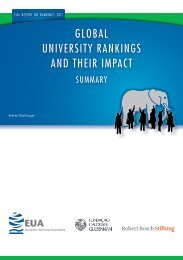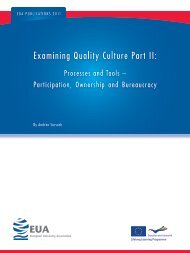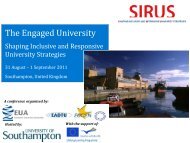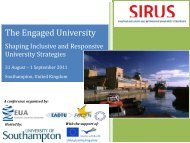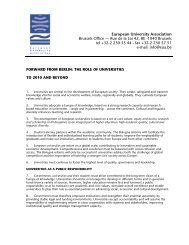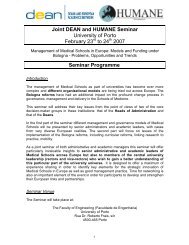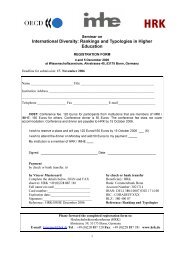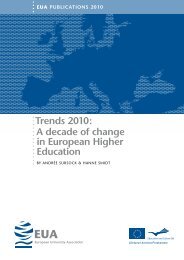Beiträge zur Hochschulforschung - European University Association
Beiträge zur Hochschulforschung - European University Association
Beiträge zur Hochschulforschung - European University Association
Create successful ePaper yourself
Turn your PDF publications into a flip-book with our unique Google optimized e-Paper software.
Overview of the study<br />
The study builds upon previous work developed by EUA on university financial sustain-<br />
ability and governance, and has involved major data collection over 27 <strong>European</strong><br />
countries. Quantitative data was collected through several questionnaires to univer-<br />
sity representatives and public authorities and qualitative data through site visits to<br />
universities and in-depth case study contributions at seminars and conferences.<br />
This paper aims to provide the reader with an overview of the study while exploring<br />
some of the key findings of this research 1 . It provides a concrete definition of income<br />
diversification, analyses its drivers and the current state of play in Europe. It further<br />
explores the challenges that universities face today in relation to the way they are<br />
funded, which framework conditions are needed for a successful diversification of<br />
funds, and finally details a “roadmap” for universities to develop such a strategy.<br />
2 Income diversification<br />
What does income diversification mean in the higher education sector?<br />
In the framework of this research project, income diversification is understood as the<br />
generation of additional income (through new or existing funding sources) that con-<br />
tributes to balancing the income structure of the institution. It is a tool to achieve fi-<br />
nancial sustainability, if the conditions in which the universities operate allow and re-<br />
quire it. In turn, financial sustainability aims to ensure a university’s academic goals<br />
are reached by guaranteeing that the institution produces sufficient income to enable<br />
it to invest in its future academic activities.<br />
The EUDIS study considers the distribution and diversification of funding sources in<br />
general and in particular within the categories of public funding and of additional (other)<br />
funding sources. The latter includes income generated from contracts with the private<br />
sector (research contracts and education-related activities), philanthropic funding, in-<br />
come generated by the provision of services – rental of facilities, residences, catering,<br />
consultancy, libraries, museums... – and income through financial activities.<br />
Figure 1 shows the diversity of entities/institutions from which universities may receive<br />
funds and the variety of how these funds may be delivered to the university.<br />
1 The report “Financially sustainable universities II: <strong>European</strong> universities diversifying income streams” is<br />
available on EUA’s website: www.eua.be/eudis.<br />
<strong>Beiträge</strong> <strong>zur</strong> <strong>Hochschulforschung</strong>, 33. Jahrgang, 2/2011 19


